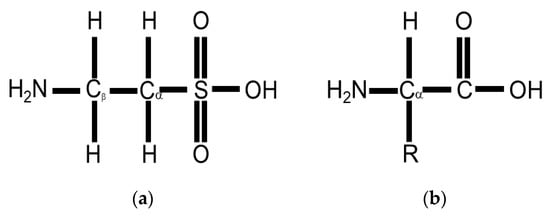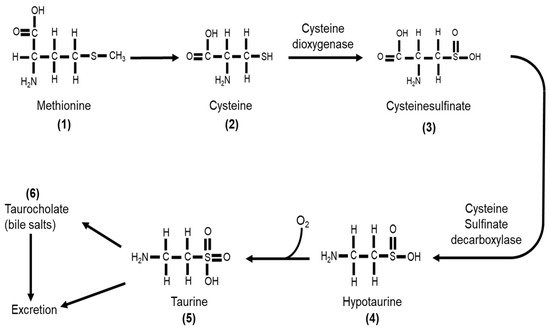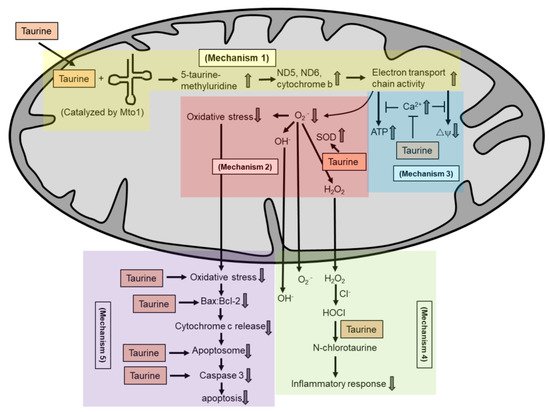Mitochondrial dysfunction, along with oxidative stress, is a key hallmark of various pathologies, such as aging
. Often, antioxidant therapy, such as coenzyme Q
, provide some protections, potentially by improving the mitochondrial function and reducing oxidative stress in these diseases. Recently, taurine, a sulfur-containing amino acid, has been approved in Japan in treating stroke-like episodes in patients with mitochondrial myopathy, encephalopathy, lactic acidosis and stroke-like episodes (MELAS), which is a mitochondrial disease
. Indeed, the use of taurine dates back to 1985, as taurine was first used to treat patients with congestive heart failure in Japan
. In addition, taurine supplementation has been shown to improve the exercise capacity of patients with heart failure
, which is likely due to improvement of the myocardial energy production. Although taurine was first identified in the 1800s
, the mitochondrial actions of taurine still remain unclear and underappreciated.
2. Taurine Biology
Taurine or 2-aminoethane-sulfonic acid is a unique amino acid as it has a sulfonyl group on the C-terminus and an amino group residing on the β-carbon (
Figure 1a) rather than α-carbon (
Figure 1b)
[33]. Taurine, therefore, is a β-sulfonic amino acid (
Figure 1). Taurine was first identified by Tiedemann and Gmelin, who isolated taurine in 1827 from the bile of the ox,
Bos taurus [32]. As described in
Figure 2, taurine (
5) is synthesized in the liver from methionine (
1) or cysteine (
2) to produce hypotaurine (
4) by cysteine dioxygenase and cysteine sulfonic acid decarboxylase (CSAD). Cysteine dioxygenase converts methionine or cysteine (
1–
2) to cysteinesulfinate (
3), while CSAD converts cysteine sulfinate (
3) to hypotaurine (
4). Hypotaurine (
4) is then readily oxidized to taurine (5), which may be excreted directly or as a conjugate with bile salts such as taurocholate (
6)
[33].
Figure 1. (a) Taurine or 2-aminoethane-sulfonic acid is a β-sulfonic amino acid as it has a sulfonyl group rather than a carboxyl group attached to the alpha carbon and an amino group on the beta carbon; (b) a standard amino acid contains an alpha carbon, to which an both an amino group and a carboxyl group are attached.
Figure 2. Taurine (5) is synthesized from either methionine (1) or cysteine (2). Cysteine dioxygenase catalyzes the conversion of cysteine (2) to cysteinesulfinate (3), which then is converted to hypotaurine (4) by cysteine sulfinate decarboxylase. Hypotaurine (4) is readily oxidized to form taurine (5), which can be excreted directly or as a conjugate with bile acids such as taurocholate (6).
In most mammals including humans, rodents and some primates, taurine is considered a conditionally essential amino acid, as cysteine dioxygenase and CSAD are present abundantly. Mammals primarily depend on taurine biosynthesis in vivo
[34] and partially from diet, such as from meat, seafood and human milk
[35][36][37]. Newborns and young infants are unable to synthesize taurine as well as adult humans, and therefore, are dependent on a taurine-supplemented diet
[38]. Clinical studies investigating infants supplemented with (30–40 μM/dL) or without taurine showed that inadequate taurine supplementation impairs lipid absorption and bile acid secretion and causes hepatic and retinal dysfunction
[39][40][41][42]. Due to the importance of taurine in neonatal development, mothers are strongly encouraged to breastfeed, due to the high concentration of taurine in breast milk, or feed infants with taurine-supplemented formulas and taurine-supplemented total parenteral nutrition
[40][42][43]. On the other hand, the activities of taurine biosynthetic enzymes are low in cats, dogs and foxes, and therefore they primarily depend on a taurine-supplemented diet
[44][45]. When fed with a diet deficient in taurine, these animals developed pathologies such as cardiomyopathy and myocardial dysfunction
[44][46][47], retinal and tapetal degeneration that leads to blindness
[48][49][50], neurological abnormalities
[51][52], weakened immune response
[53], pregnancy and fetal development complications
[54][55], as well as gastrointestinal problems
[56][57]. In contrast, when fed with taurine-supplemented diets, these animals were protected against pathologies such as cardiomyopathy
[58][59], seizure
[51][60], and retinopathy
[61], and showed improved reproductive performance and neurological development
[62]. Taurine has also been added to energy drinks such as Red Bull, Monster, Tab Energy and Rockstar
[63]. It was estimated that on average, there is 750 mg of taurine in an 8 oz can of energy drink
[63]. While energy drinks mainly provide an energy boost, the exact role of taurine in energy drinks remains unclear as energy drinks also contain additional additives such as caffeine, ginseng, vitamins, antioxidants and sugars
[64]. However, two reviews by Kurtz et al.
[65] and Seidel et al.
[66] have described the influence of taurine on exercise performance.
Taurine is ubiquitously expressed in most tissues, particularly in the excitable tissues such as the heart, retina, brain and muscles
[32]. The intracellular concentration of taurine is commonly 5–50 mM and the plasma concentration of taurine is approximately 100 μM. When taurine is supplemented, the plasma taurine content usually reaches its peak within 1 h to 2.5 h of taurine intake
[67][68]. Ghandforoush-Sattari et al.
[67] conducted an analysis on the pharmacokinetics of oral taurine supplementation (4 g) in healthy adults. These individuals, who had fasted overnight, showed a baseline taurine content in a range of 30 μmol to 60 μmol. Then, 1.5 h after taurine intake, the plasma taurine content increased to approximately 500 μmol. Plasma taurine content subsequently decreased to baseline level 6.5 h after taurine intake. This study would be consistent with the common notion that excess plasma taurine is mostly excreted via urine or being transported to tissues. As taurine is only synthesized in the liver, maintenance of a high concentration of taurine in other tissues depends on the taurine uptake from the blood via a sodium-dependent taurine transporter (
TauT). This
TauT has a higher affinity for β-amino acids, such as taurine, but a lower affinity for α-amino acids
[33]. The importance of this taurine transporter has been evidenced in mouse models lacking the
TauT gene
[69][70], as well as in in vivo and in vitro studies utilizing taurine transporter competitive inhibitors, such as β-alanine
[71][72] or guanidinoethanesulfonate (GES)
[73][74].
Two mouse models lacking the
TauT (TauTKO) were generated by Ito’s group
[69] and Warskulat’s group
[70]. Both TauTKO mouse models had reduced taurine concentrations in the heart, skeletal muscles and retina, validating the requirement of the taurine transport from the liver to these tissues
[69][70]. As a consequence of taurine deficiency, these TauTKO mice developed retinal degeneration, chronic liver disease, muscle atrophy, a decrease in exercise capacity and increased susceptibility to streptozotocin-induced diabetic nephropathy
[69][70][75][76][77]. The TauTKO mice developed by the Ito’s group also showed evidence of cardiomyopathy, as indicated by diminished fractional shortening; ventricular remodeling, as shown by dilated ventricles; and reductions in ventricular wall thickness, as well as increased expression of fetal genes that serve as heart failure markers, such as atrial natriuretic peptide (ANP), brain natriuretic peptide (BNP) and β-myosin heavy chain (MHC)
[69]. Further examination of the TauTKO hearts revealed mitochondrial swelling and disruption of the outer mitochondrial membrane, as well as a reduction in the activity of succinate dehydrogenase (SDH), which is a marker of mitochondrial enzyme
[69]. In addition, TauTKO hearts contained defective mitochondria, as evidenced by smaller mitochondria size, impaired activities of the electron transport chain, oxidative stress and apoptosis
[78]. The TauTKO hearts were also associated with impaired autophagy, which is the cellular quality control in degrading damaged proteins or organelles
[79][80]. Defective mitochondria and impaired autophagy in TauTKO hearts, therefore, may contribute to the underlying development of cardiomyopathy in TauTKO mice. In addition, the same TauTKO mice showed premature aging, as characterized by shortened lifespan and acceleration of skeletal muscle senescence
[81]. Interestingly, while the TauTKO mice developed by the Warskulat’s group showed normal cardiac function, the expression of fetal genes such as ANP, BNP and CARP (cardiac ankyrin repeat protein) increased in the TauTKO hearts, suggesting taurine depletion may predispose the mice to the development of a heart failure
[70]. Based on the studies from these mouse models that lacked the
TauT, it is convincing that taurine indeed has multiple physiological roles that include maintaining mitochondrial function.
Similarly, pharmacological inhibition of taurine transport using β-alanine or GES in both in vitro and in vivo studies resulted in significant pathological conditions, which include atrophic cardiac remodeling
[69][82][83], oxidative stress
[84][85], increased apoptosis
[86], mitochondrial defects
[87][88] and altered cardiac cell morphology
[89], as well as loss of retinal ganglion cells that lead to retinopathy
[71]. All these studies clearly demonstrated the importance of taurine as a cytoprotective agent with multiple physiological functions. Recently, increasing studies have focused on the antioxidant role of taurine in maintaining mitochondrial function.



